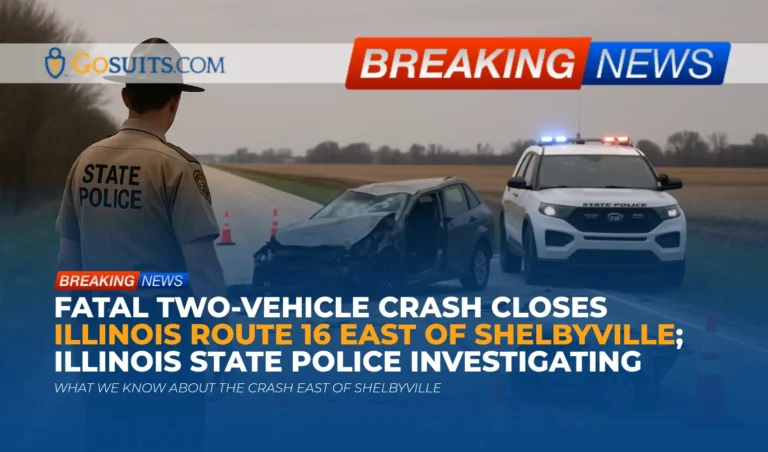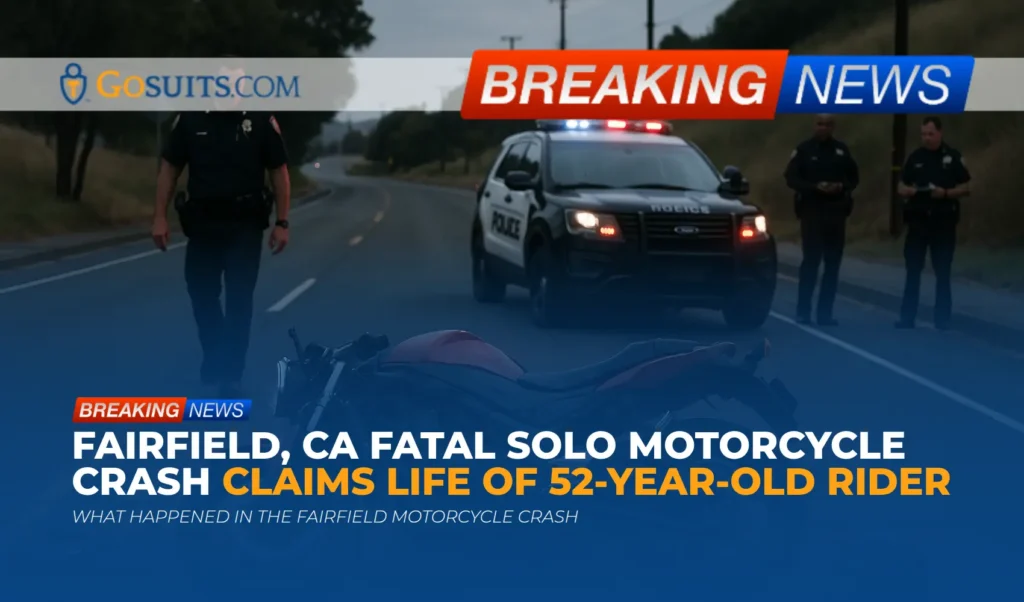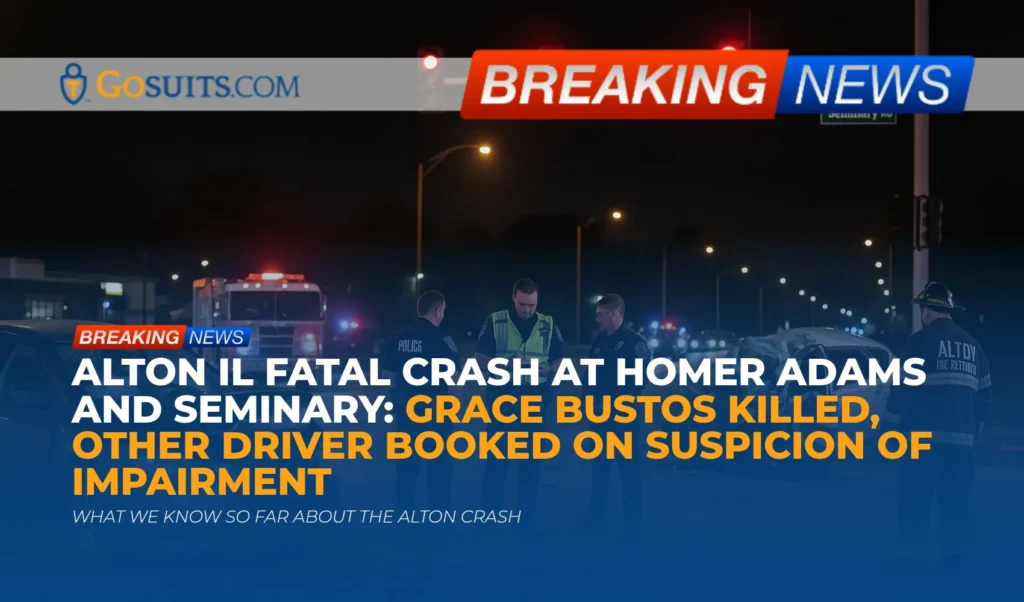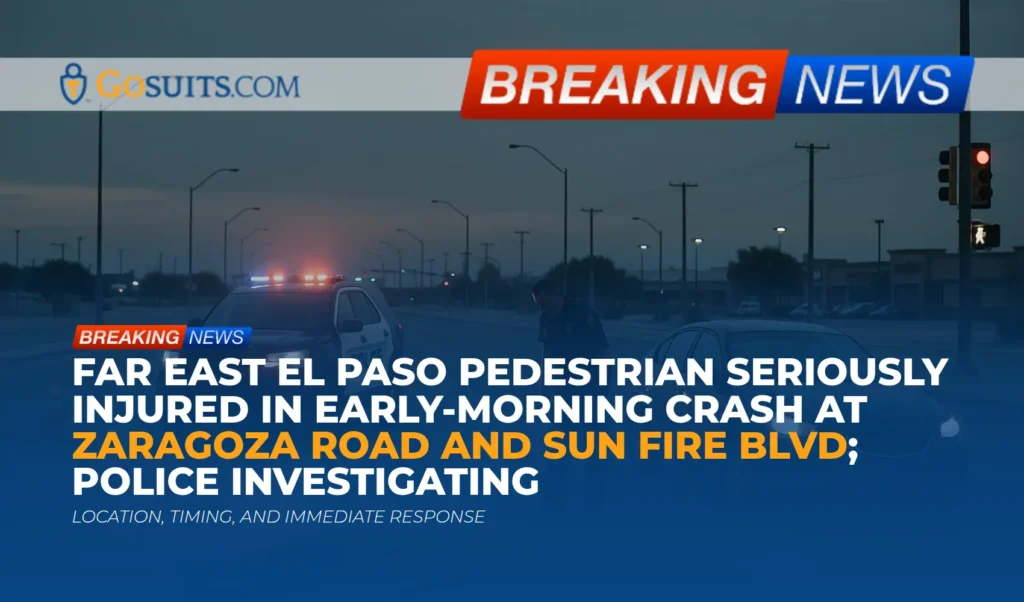- What we know about the crash east of Shelbyville
- Where and when it happened, road closure and detours
- Agencies involved and official statements so far
- Why closures and investigations take time
- How families can get official information and documents
- Police crash report
- Coroner notification and autopsy report
- Death certificate
- Towing and vehicle release
- Traffic cameras and other public records
- Practical steps to preserve evidence and protect rights
- Understanding potential civil liability after a two-vehicle fatal crash in Illinois
- Wrongful death and survival claims
- Comparative fault in Illinois
- Insurance coverage issues commonly involved
- Time limits that may apply
- Community safety considerations for Route 16 and similar rural highways
- Credible resources and references
- Why acting promptly matters
- Commentary from Gosuits Shelbyville, Illinois Personal Injury Attorney
What we know about the crash east of Shelbyville
Illinois State Police reported a two-vehicle fatal crash on Illinois Route 16 near County Road 2450E, east of Shelbyville in Shelby County. Troopers from State Police Troop 7 responded shortly after 8 a.m., and officials confirmed that Route 16 was closed at the crash location with traffic diverted at Illinois Route 32 while investigators worked the scene. The Shelby County Coroner’s Office confirmed involvement at the scene, and both State Police and the Coroner’s Office indicated that no additional public information would be released at the time of the initial updates. This was characterized first as a serious personal injury crash and later confirmed as a fatal crash.
As of the last public update, authorities had not released details such as the identities of those involved, how the collision occurred, the makes or models of the vehicles, or whether any citations were issued. This is common during the early stages of a serious crash investigation, especially while next-of-kin notifications are pending.
Where and when it happened, road closure and detours
The incident occurred on Illinois Route 16 at or near County Road 2450E, approximately six miles east of Shelbyville in Shelby County, Illinois, during the morning hours. State Police indicated the response time was around 8:03 a.m. for the confirmed fatal update. Route 16 was closed at the crash scene, with traffic being rerouted at Illinois Route 32.
When major incidents occur on an arterial highway like Route 16, temporary detours are often put into place to maintain safety for first responders and the public. Drivers approaching an active crash scene are generally advised to reduce speed, follow detour signage, and use caution until the roadway reopens.
Agencies involved and official statements so far
According to the initial updates, the following agencies were on scene or involved in managing the incident and its aftermath:
- Illinois State Police (ISP) Troop 7 responded, secured the scene, and began the crash investigation. ISP typically coordinates with local responders and may conduct crash reconstruction when a fatality is involved.
- Shelby County Coroner’s Office responded to handle decedent matters, including pronouncement, next-of-kin notification, and determinations related to cause and manner of death.
- Illinois Department of Transportation (IDOT) assisted with roadway closures, traffic control, and detours, as needed, for public safety while the scene remained active.
- Shelby County Sheriff’s Office communicated a road closure shortly after the crash was reported, consistent with managing traffic in the area and supporting the scene.
At the time of the updates noted above, officials indicated that no further details were being released. Families directly affected typically receive information before the public to ensure privacy and sensitivity.
Why closures and investigations take time
Fatal crash scenes require a thorough, methodical approach. Investigators may gather measurements, document debris fields, photograph vehicle damage, and, where appropriate, use specialized reconstruction methods to determine speeds, vectors, and other dynamics. This work is time-sensitive because weather, traffic, and towing can alter important physical evidence.
In addition, the Coroner’s Office has statutory responsibilities that include establishing identity, undertaking examinations, and at times ordering autopsies to determine cause and manner of death. While this process is ongoing, public details are often limited. This is done to preserve the integrity of the investigation, ensure accurate reporting, and respect the privacy of those involved and their families.
How families can get official information and documents
In the days and weeks after a serious crash, several official documents can help families understand what happened and begin administrative and legal processes. The steps below are general guidance for incidents on state highways in Illinois and may vary based on the specific circumstances of the investigation.
Police crash report
The primary law enforcement report is typically generated by the agency that handled the scene. Here, initial reporting indicates the Illinois State Police responded. In Illinois, crash reports and related records can often be requested through the Illinois State Police’s public records process. Some records may be withheld while an investigation is active.
- Where to request: Illinois State Police public records are processed through the agency’s Freedom of Information Act (FOIA) portal. See Illinois State Police FOIA.
- What to request: The “Illinois Traffic Crash Report,” any supplemental narratives, diagrams, and photographs, if available. Provide the date, time, location (IL Route 16 near 2450E, east of Shelbyville), and known vehicle or party information.
- When to request: A FOIA request can be submitted promptly, but be aware that active investigations may delay release. Illinois FOIA generally requires an initial response within five business days, although extensions can apply. See the Attorney General’s guidance at Illinois Attorney General FOIA information.
Coroner notification and autopsy report
In fatal crashes, the county coroner is responsible for certain examinations and for determining cause and manner of death. Illinois law outlines coroner duties and authority.
- Office to contact: Shelby County Coroner’s Office. Families can request information about release procedures, autopsy status if performed, and how to obtain reports when available.
- Legal framework: See coroner duties in Illinois law at 55 ILCS 5/3-3013.
- What to ask for: Confirmation of next-of-kin notification, autopsy report availability (if applicable), any toxicology testing timelines, and procedures for obtaining copies. Some records may be withheld until investigations are complete.
Death certificate
Certified copies of the death certificate are often needed for insurance claims, benefits, and administrative processes. In Illinois, death records are maintained through the Illinois Department of Public Health (IDPH) and local vital records offices.
- Where to request: See IDPH’s guidance on death records at Illinois Department of Public Health Death Records.
- What to prepare: Proof of identity and relationship, and relevant details such as date of death and county.
- Timing considerations: The death certificate may be pending completion of the coroner’s determination of cause and manner of death.
Towing and vehicle release
Vehicles involved in fatal collisions are commonly held by law enforcement or towed to a secure facility for investigation. Families may need to coordinate retrieval of personal property and, later, the vehicle itself.
- Who to contact: The investigating agency (Illinois State Police Troop 7) or the local sheriff’s office can advise where the vehicle was taken and whether a hold remains in place.
- Why it matters: Access to the vehicle may be essential for insurance evaluation and, where appropriate, independent inspection or preservation of evidence. Coordinate any inspections through the towing facility and the investigating agency.
Traffic cameras and other public records
Some government agencies maintain cameras or data systems that may capture traffic flow, weather, or roadway conditions. Not all cameras record or retain footage, and retention periods can be short.
- Public records requests: Consider FOIA requests to relevant agencies for available data related to the time and location of the crash. Guidance on FOIA in Illinois is provided by the Attorney General at this page.
- IDOT resources: IDOT maintains safety and crash data resources and may have roadway information relevant to broader safety context. See Illinois Department of Transportation and its crash data portal at Illinois Roadway Crash Data.

Practical steps to preserve evidence and protect rights
After a serious crash, early, careful action can make a real difference in understanding what happened and in protecting legal rights. The following steps are general guidance; circumstances vary.
- Keep documentation organized: Save all correspondence from law enforcement, the coroner, medical providers, and insurance carriers. Create a secure file for reports, claim numbers, and bills.
- Preserve photos and videos: If any photos or videos of the scene, vehicles, or road conditions exist, back them up in more than one place. Note the date, time, and who took them.
- Identify potential witnesses: Write down names, phone numbers, and what each person saw or heard. Even brief observations can be important later.
- Avoid repairs or disposal without guidance: Do not authorize repairs to involved vehicles or dispose of potentially relevant items until you understand whether an inspection is needed.
- Be cautious with insurance communications: Before giving any recorded statement to an insurance company, consider first consulting with a qualified attorney for a free consultation to understand your rights. What is said to an insurer can be used to reduce or deny claims later.
- Consider independent preservation letters: In some cases, sending written notice to potentially responsible parties to preserve evidence (such as electronic data, logs, or maintenance records) is important. An attorney can handle this to ensure compliance with legal standards.
Understanding potential civil liability after a two-vehicle fatal crash in Illinois
Because the investigation is ongoing and no causation information has been released, it is not appropriate to speculate about fault. Still, families often ask what kinds of legal issues arise in a two-vehicle fatal crash on a state route. Below are general considerations under Illinois law.
Wrongful death and survival claims
Illinois law recognizes two types of civil claims following a fatal injury:
- Wrongful death claim: Brought for the benefit of surviving next of kin to address their losses resulting from the death, such as loss of financial support and society. See the Illinois Wrongful Death Act at 740 ILCS 180.
- Survival claim: Allows recovery for damages the decedent could have claimed if they had survived, such as conscious pain and suffering and medical expenses, carried forward by the estate. See the Survival provisions of the Illinois Probate Act at 755 ILCS 5/27-6.
These claims are typically brought by a personal representative of the decedent’s estate. Who serves in that role can depend on whether there was a valid will and other probate considerations.
Comparative fault in Illinois
Illinois follows a modified comparative fault rule. A claimant’s recovery can be reduced by their percentage of fault, and recovery is generally barred if the claimant is more than 50 percent at fault. See 735 ILCS 5/2-1116. In a two-vehicle crash, insurers and investigators may analyze speed, right-of-way, impairment, distraction, roadway conditions, and visibility to assess proportionate responsibility.
Insurance coverage issues commonly involved
Multiple layers of insurance may be implicated, depending on the facts:
- Liability coverage of involved drivers: This coverage addresses claims alleging negligence against an at-fault driver. Investigation findings tend to guide how liability carriers evaluate fault.
- Uninsured/underinsured motorist (UM/UIM): If the at-fault party lacks adequate coverage, UM/UIM under the decedent’s or household policies may apply, depending on policy language.
- Medical payments or PIP: Some policies include limited medical payments benefits regardless of fault, which can help address immediate expenses.
- Potential commercial coverage: If a commercial vehicle was involved, additional policies or corporate defendants may enter the analysis; early preservation of records (maintenance logs, driver qualification files, telematics) becomes critical.
Insurance companies often request recorded statements or authorizations early. Before engaging in detailed communications with any insurer, consider consulting an attorney to understand what information must be provided, and what can wait until a clearer picture emerges.
Time limits that may apply
Illinois law imposes deadlines for bringing civil claims, and shorter deadlines can apply in special circumstances. General timelines include:
- Personal injury: Typically two years from the date of injury. See 735 ILCS 5/13-202.
- Wrongful death: Generally two years from the date of death, with some specific exceptions. See 740 ILCS 180/2.
If a governmental entity is potentially involved, special notice requirements or shorter limitations may apply. Because deadlines can be complex and fact-specific, consider seeking a free consultation promptly to review the particular circumstances.
Community safety considerations for Route 16 and similar rural highways
While investigators determine the facts of this crash, it is appropriate to reflect on general safety concerns associated with rural state highways in Illinois. Rural corridors often feature higher speed limits, fewer controlled intersections, and changing sight lines. During morning hours, sun angle, agricultural traffic, or seasonal conditions can add to the challenges.
IDOT’s crash data resources show that severe crashes occur on both rural and urban roads statewide. Proactive steps can help reduce risk:
- Speed management: Observe posted limits and adjust for conditions, particularly on undivided highways.
- Passing with care: Only pass when legal and when sight distance and oncoming traffic conditions support a safe maneuver.
- Intersection awareness: At rural cross-roads and driveways, anticipate vehicles entering from stop-controlled side roads or private drives.
- Attention and visibility: Minimize distractions, use headlights as conditions warrant, and maintain safe following distances.
- Yield to emergency scenes: Slow down and move over for stopped emergency and maintenance vehicles, and follow detours as directed.
These are general reminders; they are not directed at any person involved in this incident and do not imply causation.
Credible resources and references
The following government sources provide reliable guidance and context related to the topics discussed here:
- Illinois State Police — agency information and public records links.
- Illinois State Police FOIA — request crash reports and related records, subject to investigation status and applicable exemptions.
- Illinois Attorney General FOIA information — statewide guidance on public records requests and timelines.
- Illinois Department of Transportation — statewide transportation and safety information.
- Illinois Roadway Crash Data — IDOT crash facts and statistics.
- Illinois Department of Public Health: Death Records — how to obtain certified death certificates.
- Illinois Wrongful Death Act (740 ILCS 180) — general statutory framework.
- Illinois Survival provisions (755 ILCS 5/27-6) — survival actions by the estate.
- Comparative fault (735 ILCS 5/2-1116) — allocation of fault and effect on recovery.
- Personal injury limitation period (735 ILCS 5/13-202) — general two-year period.
- Wrongful death limitation period (740 ILCS 180/2) — time to bring action.
- Coroner duties (55 ILCS 5/3-3013) — selected statutory responsibilities.

Why acting promptly matters
When a serious crash is under investigation, there are immediate and practical reasons to take timely action, even while waiting for official reports. The purpose of this section is to highlight practical steps and the reasons behind them, not to direct anyone personally or to solicit contact.
- Evidence can be lost quickly: Skid marks fade, scene debris is cleared, vehicles are repaired or salvaged, and electronic data can be overwritten. Early steps to preserve vehicles, photos, and documents help ensure the facts can be evaluated later.
- Short retention periods for records: Some video systems and dispatch audio logs recycle data within days or weeks. Prompt public records requests can prevent loss of potentially relevant information.
- Insurance companies move fast: Carriers may seek recorded statements and medical authorizations soon after a loss. Understanding what must be shared, and when, helps avoid inadvertent statements that could be used to minimize or deny claims. Before engaging extensively with any insurer, it is prudent to consult with an attorney for a free case review to understand rights and options.
- Coordinating benefits and expenses: Timely requests for death certificates, coordination with employers and benefits administrators, and notifying applicable insurers can streamline necessary administrative tasks.
- Legal timelines do not pause: Statutory deadlines for civil claims and for specific notices continue to run. Early planning helps ensure no rights are forfeited by delay.
- Peace of mind through information: Having a clear plan for obtaining official documents, preserving evidence, and managing communications can reduce uncertainty during a difficult time.
Commentary from Gosuits Shelbyville, Illinois Personal Injury Attorney
Our hearts are with everyone affected by the fatal crash reported east of Shelbyville on Route 16. Losing a loved one or facing life-changing injuries without warning is devastating. This overview is intended for educational purposes and general information as the community awaits official findings.
From a personal injury perspective, a two-vehicle fatal crash on a state highway raises important questions about right-of-way, visibility, roadway configuration, speed, and driver decision-making. It is appropriate that investigators and the Coroner’s Office are taking the necessary time to gather facts before releasing conclusions. While we do not know the cause and will not speculate, a careful evidence-based reconstruction is vital to ensuring accountability and clarity for those most affected.
In the aftermath of a serious crash, insurance companies and corporate actors often move quickly. They may seek recorded statements, broad medical authorizations, or early settlements before the full picture is known. This can take advantage of a family’s lack of familiarity with claim processes and the pressure of urgent expenses. Statements made to insurers can be used later to challenge liability or damages, and premature agreements can limit the ability to pursue a complete recovery. Understanding the process, the relevant coverages, and the role of comparative fault in Illinois helps level the playing field.
Obtaining a free consultation with a seasoned and skilled personal injury attorney can provide clarity about next steps, including how to preserve evidence, how and when to communicate with insurers, and what documents to request from public agencies. Even a brief discussion can help identify immediate priorities and timelines, so families can make informed decisions while the official investigation proceeds.






